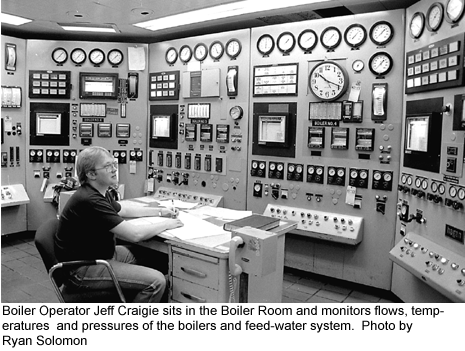The University Record, May 20, 1997
Power Plant keeps things going on Central Campus
By Ryan Solomon
 It is always there humming in the background. It would probably go unnoticed were it not for its two smokestacks, the tallest rising 240 feet above campus.
It is always there humming in the background. It would probably go unnoticed were it not for its two smokestacks, the tallest rising 240 feet above campus.
“It” is the Central Power Plant located east of the Power Center for the Performing Arts and providing all the steam and approximately 67 percent of the electricity demand on Central Campus. Energy for the Medical Center, North Campus and South Campus is furnished by Detroit Edison.
When compared to municipally-owned electric utilities in the state, only utility companies in Lansing and Holland manage more kilowatt-hours per year than U-M’s electrical system, says Utilities Systems Manager Bill Verge. Utilities Systems is responsible for buying, generating, distributing and billing for all utilities of University-owned or leased facilities anywhere in the country.
The Central Campus Power Plant is a cogeneration plant, which means it produces both electricity and steam. The power plant started as a provider of only steam when built in 1915 and met all the needs of 1,120 faculty and staff and 5,759 students.
Sometime in the mid 1920s it began generating electricity. Besides heating most Central Campus buildings, the power plant also generates and distributes chilled water for air conditioning, hot water, compressed air, and medium-pressure steam used in dishwashers and laboratories. Natural gas is the primary fuel, and there is a 950,000-gallon heating oil backup if the natural gas supply is disrupted.
The University has enjoyed the benefits of a deregulated natural gas market and is closely following the process that will deregulate electricity. Natural gas was deregulated around 1984, and in 1987 the
U-M began buying natural gas on the open market to fuel the power plant. Since 1987, it has been estimated the University has saved nearly $55 million buying natural gas in a deregulated market.
Utilities Systems staff are now preparing for how U-M will be affected by a deregulated electricity market. The Michigan Public Service Commission has recommended a phased-in electric deregulation plan that would allow all Michigan residential and business customers to choose among competing electric companies by 2004.
Verge’s staff estimates the U-M could save $3.8-$5.7 million on its annual electric bill of approximately $19 million per year. Verge has compared the U-M’s electricity purchase costs with other Big Ten schools and found that Detroit Edison’s rates are high. “Our average cost is something like 1.7 times as much as the average of the other Big Ten universities,” he notes.
Verge says having an uninterrupted flow of electricity is more than just a convenience for students, faculty and staff. Faculty and research scientists depend on a reliable supply of electricity to teach and conduct experiments. “If you think of a big industrial plant, they can think in terms of interruptible power. They might have to send some people home. They might lose some money that day. That’s not an option for the University.”
Verge accepts his unit’s anonymity. “We are always working in the background. And the only time anybody thinks of us is when their lights blink or their office gets cold,” which, he says with a chuckle, “we hope does not occur very often.”
An inside look at the power plant
Here is an overview of how the Central Power Plant staff of 22 engineers and operators generates 161 million kilowatt hours of electricity annually.
Ann Arbor city water enters the power plant and immediately goes through one of three water softeners before it is piped through one of three demineralizers, which reduce corrosion in the pipes. The water then moves through two magnetic filters that remove iron deposits before being pumped through three deaerators that remove air and other non-condensable gases. The water is then pumped into one of eight boilers where it is heated to 750° F and becomes steam pressurized at 400 psi. The steam enters one of four steam turbine generators that produce electricity.
At this point in many power plants, the exhaust heat from the steam turbine generator is wasted when it is vented through cooling towers. However, the U-M plant keeps the exhaust heat and uses it to heat and cool buildings. Verge says using this process to generate steam and electricity maximizes efficiency. “There’s very little waste in a system like this, which allows us to achieve efficiencies in the 80-percent range.”
The power plant also has two jet engine-like turbines that are fueled by natural gas. These turbines produce electricity and 1,000° F exhaust air, which is fed back into the boilers. Recycling the hot exhaust air means that the plant uses less natural gas because the incoming air used for combustion enters the boilers at 1,000° F instead of air that would normally be drawn at approximately 70° F. The heated water and air create steam that enters one of four steam turbine generators to produce electricity.

